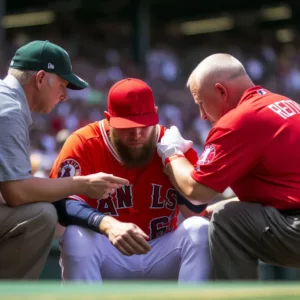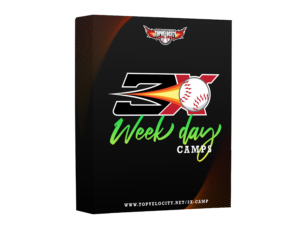Are you looking for the Average Pitching Velocity by Pitch & Age? You will find it here!
 When studying the complexities of baseball and the abilities of the players, the velocity of the pitch frequently emerges as a critical aspect. The ability to throw a baseball at high speeds adds a level of challenge for batters while also increasing a pitcher's chances of winning. The average pitch velocities classified by age can provide important insights into an athlete's evolution in this sport.
When studying the complexities of baseball and the abilities of the players, the velocity of the pitch frequently emerges as a critical aspect. The ability to throw a baseball at high speeds adds a level of challenge for batters while also increasing a pitcher's chances of winning. The average pitch velocities classified by age can provide important insights into an athlete's evolution in this sport.
An examination of average pitch speeds across different age demographics reveals a significant association with competence, physical prowess, and development. Players' ability to generate and control higher speeds improves with age and experience. Furthermore, as young athletes improve physically, pitch speed often increases due to increased strength and conditioning.
In this composition, we will examine several age groups to provide a summary of average pitching velocities. This assessment will highlight the path from childhood to maturity, graphically portraying the evolution of the craft and the commitment players put into improving their pitching abilities.
Average Pitching Velocity by Pitch & Age
Little Leagues (youth leagues)
Due to the increasing arm strength and mechanics of these young participants, youth leagues such as Little League Baseball, which normally accommodate kids ages 9-12, see considerably slower pitch speeds. The median speed for pitches in this age range is usually between 40 and 50 mph.
- 9-10 years old: 40-45 miles per hour
- 11-12 years old: 45-50 mph.
Baseball at the High School Level
Pitching speeds increase as athletes progress through high school, owing to increased arm strength and refined technique. The average pitching speeds for high school baseball are as follows:
- Freshmen (aged 14-15): 65-75 mph
- Sophomores (ages 15-16): 70-80 mph
- Juniors (ages 16-17): 75-85 mph
- Seniors (17-18 years old): 80-90 mph.
Baseball at the College Level
Athletes continue to physically mature while honing their pitching techniques in college, resulting in faster pitch speeds than in high school. The following are the median pitch speeds for college baseball players:
- NCAA Division I:: 85-95 mph
- NCAA Division II: 80-90 mph
- NCAA Division III: 75-85 mph
Baseball at the highest level
Given their higher physical conditioning and highly sophisticated skill sets, professional baseball players are likely to have the greatest average pitch velocity. Pitchers in Major League Baseball (MLB) frequently exceed 90 mph. In professional baseball, the median pitch speeds are:
- Minor League: 85-95 miles per hour
- Major League: 90-100 mph plus
It is important to remember that these data represent average pitch speeds, and that individual pitchers might vary significantly. Athletes of all ages, particularly pitchers, can grow at different speeds and have unique abilities that influence their pitch speed.
Average Pitching Velocity by Pitch & Age
 The Fastball: A Speed Machine
The Fastball: A Speed Machine
The fastball has a prominent place in baseball due to its extraordinary speed, which is designed to put the batter's reflexes to the test. The following are the average fastball speeds for various age groups:
- 40-50 mph: 8 to 10.
- 50-60 mph: 11-12 years old
- 60-70 mph: 13-14 years old
- 70-80 mph: 15-16 years old
- 75-85 mph: for high school
- 85-95+ mph: for college/professional
The four-seam fastball, two-seam fastball, and cutter are all fastball varieties.
The Curveball: A Deception Dance
Curveballs are breaking balls that swerve downward and away from the batter. To generate a spin that causes the ball's trajectory to vary, a particular grip and wrist action are required. Curveball speeds vary by age group and are as follows:
- 45-55 mph: 11-12 years old
- 55-65 miles per hour: 13-14 years old.
- 65-75 mph: for 15-16 year olds
- 70-80 mph: for high school
- 75-85 mph: for college/professional
The Slider: Sudden and Sharp
A slider is a type of breaking ball that has a late, sharp break. It has the same arm speed as a fastball but a different grip and wrist motion. The normal slider speeds by age are as follows:
- 13-14 years old: 55-65 miles per hour
- 65-75 mph: for 15-16 year olds
- 70-80 mph: for high school
- 80-90 mph: for college/professional
The Change-up: The Disguise Master
A changeup is an off-speed pitch that mimics the appearance of a fastball while arriving at a slower speed. The grip and throwing mechanics are modified to minimize velocity while retaining arm speed. The following are the average changeup speeds by age:
- 40-50 miles per hour: 11-12 years old.
- 50-60 mph: 13-14 years old
- 60-70 mph: 15-16 years old
- 65-75 mph: for high school
- 75-85 mph: for college/professional
Average Pitching Velocity by Pitch & Age
| Age | Average Pitch Speed |
|---|---|
| 9-10 | 40-50 mph |
| 11-12 | 50-60 mph |
| 13-14 | 60-75 mph |
| 15-16 | 70-80 mph |
| 17-18 | 75-85 mph |
 The Pitching Velocity Chart depicts the average pitching velocity associated with different age groups for baseball players. This chart, which is divided into distinct age categories, is useful for coaches, players, and scouts to evaluate and compare the abilities of various pitchers.
The Pitching Velocity Chart depicts the average pitching velocity associated with different age groups for baseball players. This chart, which is divided into distinct age categories, is useful for coaches, players, and scouts to evaluate and compare the abilities of various pitchers.
Starting with Little League players aged 9-10, the average pitch speed ranges between 40 and 50 mph. As these athletes reach the 11-12 age group, their median pitch speed increases to around 50 to 60 mph. The biggest noticeable increases in pitching velocity occur throughout the adolescent years.
The majority of high school pitchers aged 13-14 can deliver pitches at speeds ranging from 60 to 75 mph. When these athletes reach the 15-16 age group, the average speed of their pitches ranges from 70 to 80 mph. In exceptional circumstances, exceptionally gifted high school pitchers can achieve a striking speed of 90 mph or higher.
It's important to realize that these velocities are averages, and actual velocity can vary greatly across pitchers. Pitching velocity is greatly influenced by factors such as size, power, mechanics, and physical training, which give each pitcher their individual characteristics.
Average Pitching Velocity by Pitch & Age
How to Increase Pitching Velocity
 Practicing for Increased Velocity
Practicing for Increased Velocity
A serious effort toward velocity training is required to improve pitching speeds. This type of training includes the following components:
- Increasing total body strength.
- 2lb medicine balls are being thrown.
- 3X Pitching Throwing Drills are being implemented.
- Participating in Olympic Lifting.
- Plyometric exercises are being performed.
Pitchers can build their throwing strength by including these workouts into their training routine, resulting in a significant boost in pitching velocity.
3X Pitching Mechanics
Refining pitching mechanics is another important aspect of increasing velocity. Pitchers should focus on a few crucial areas:
- Lift Leg Momentum
- The Load Position
- Triple Extension & Hip to Shoulder Separation
- Chest Thrust External Rotation
- Internal Rotation Pronation
- 2X Stabilization
A pitcher can ensure their complete body performs cohesively by perfecting these mechanics, increasing energy transfer from the lower body through the upper body and into the baseball.
Power Seeking
Another important aspect of increasing pitching velocity is power. Developing explosive strength in the legs, hips, and core is essential for developing a forceful pitching motion. This can be accomplished by incorporating:
- Squats
- Deadlifts
- Power cleans
- Core strength workouts
A pitcher can generate more force by strengthening his lower body and core, resulting in enhanced velocity on the mound.
Health Preservation
Maintaining excellent health is essential for consistent growth in pitching velocity. Proper diet, enough rest, and injury prevention strategies all have a big impact on a pitcher's success. Pitchers should do the following to keep their bodies in optimum condition:
- Maintain a healthy diet that is high in lean proteins, healthy fats, and complex carbohydrates.
- Sleep should be prioritized for effective muscle repair.
- Use appropriate stretching and warm-up practices.
- To avoid undue stress on the arm, gradually increase the intensity and volume of training.
Pitchers can improve their overall health by following these rules, setting the framework for continuing improvements in pitching velocity.
Average Pitching Velocity by Pitch & Age
Pitch Speed Calculation
Pitch speed is also important for understanding a pitcher's performance. The radar gun, which produces a radio signal and detects the reflection from moving objects such as a baseball, is one of the most frequent devices used for this purpose. The accuracy of radar weapons is determined by various factors, including:
- Distance: The radar gun should be placed at a reasonable distance from the pitcher. The device is usually placed behind the pitcher or behind the catcher.
- Angle: To achieve accurate readings, the device should be aligned with the course of the baseball.
- Calibration: It is critical to calibrate the radar gun on a regular basis in order to preserve its accuracy.
Precautions and Potential Risks
 The average pitch speed varies by age group, and taking safeguards might assist young athletes avoid injury. It is critical to evaluate physical limitations and make appropriate adjustments during training and gameplay while considering potential dangers.
The average pitch speed varies by age group, and taking safeguards might assist young athletes avoid injury. It is critical to evaluate physical limitations and make appropriate adjustments during training and gameplay while considering potential dangers.
The strain and pressure put on the arm, specifically the elbow and shoulder, is one of the key risks connected with pitching at faster speeds. To avoid injuries, use the following precautions:
- Before any throwing or pitching practices, encourage young players to stretch and warm up their arm muscles.
- To avoid overuse injuries, keep track of pitch counts and limit excessive pitches based on age recommendations.
- Encourage young athletes to participate in other sports or positions other than pitching to help spread physical stress more equally.
Another important factor to consider is the development of good technique. A good foundation in pitching mechanics can not only improve performance but also reduce the risk of injury. In order to address this:
- Work closely with TopVelocity coaches and trainers who can advise you on effective pitching techniques.
- In giving the pitch, emphasize the significance of body coordination and follow-through.
- To create a balanced and varied throwing repertoire, athletes should be trained in both fast-pitch and off-speed pitching strategies.
Finally, be prepared for the possibility of exhaustion and overuse, which can increase the risk of injury. Important considerations include:
- Making sure young pitchers get enough rest between games and pitching sessions.
- Strength and conditioning regimens with an emphasis on the core and shoulder muscles.
- Fostering open communication among coaches, athletes, and parents so that any concerns can be handled as soon as possible.
Young pitchers can grow their talents and increase their average pitching speed in a safe and productive manner by keeping these potential risks and safeguards in mind.
Following the Average Pitching Velocity by Pitch & Age
Beginning the 3X Velocity Journey
 The road to becoming a professional pitcher is not easy; it demands consistent dedication, effort, and a lot of work. The 3X Velocity Camp is an excellent platform for taking your pitching game to the next level.
The road to becoming a professional pitcher is not easy; it demands consistent dedication, effort, and a lot of work. The 3X Velocity Camp is an excellent platform for taking your pitching game to the next level.
At the camp, you'll be able to hone your talents, learn from the finest in the industry, and receive specific velocity training, pitching mechanics improvement, and injury avoidance advice. The camp setting fosters growth by creating a competitive yet collaborative environment in which you can interact with people who have similar aspirations.
The 3X Velocity Camp provides a complete training program for people who are serious about increasing their pitching velocity and turning into a professional-level athlete. We emphasis on mental strength, strategic gameplay, and establishing a strong work ethic in addition to physical excellence.
So, why delay? Invest in your baseball future today. Enroll in the 3X Velocity Camp and begin your quest to being the best pitcher you can be. Come join us to hone your skills, learn, and grow while setting the mound on fire with your increased pitching velocity!


 The Fastball: A Speed Machine
The Fastball: A Speed Machine Practicing for Increased Velocity
Practicing for Increased Velocity
Trackbacks/Pingbacks